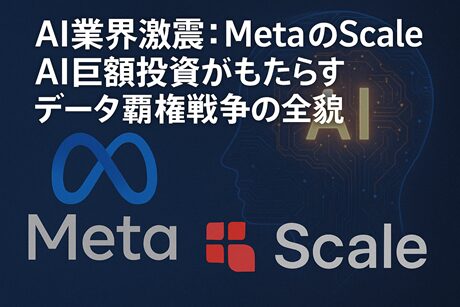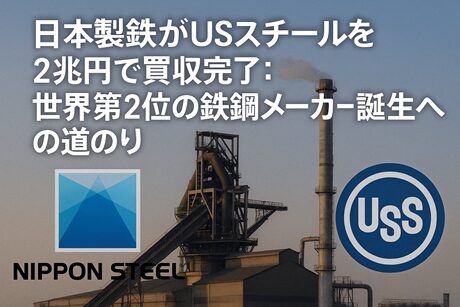目次
- 1 NVIDIA’s Path to $6 Trillion: AI’s Golden Wave
- 1.1 NVIDIA’s Current Position and Market Standing
- 1.2 NVIDIA as the Driving Force of the AI Boom
- 1.3 AI Infrastructure Becoming “National Infrastructure”
- 1.4 Expanding AI Market and Impact on Semiconductor Industry
- 1.5 Definition of Generative AI and Corporate Implementation
- 1.6 Intensifying Competition in AI Semiconductor Market
- 1.7 The “Inconvenient Truths” of the AI Boom
- 1.8 The “AI Bubble” Perspective
- 1.9 Future Outlook and Strategic Considerations
- 1.10 The AI Boom from an Investment Perspective
- 1.11 NVIDIA’s Latest Developments
- 1.12 Summary: The Path to $6 Trillion and Its Challenges
NVIDIA’s Path to $6 Trillion: AI’s Golden Wave
The artificial intelligence (AI) boom that has driven NVIDIA’s stock price shows no signs of abating, with Loop Capital suggesting the company’s market capitalization could ultimately reach $6 trillion (approximately 875 trillion yen). This represents a 60% increase from NVIDIA’s current market cap of approximately $3.7 trillion. Loop analyst Ananda Baruah describes this situation as entering “the next ‘golden wave’ of generative AI adoption.”
NVIDIA’s Current Position and Market Standing
As of June 25, 2025, NVIDIA’s market capitalization fluctuates between approximately $3.7 trillion and $3.763 trillion, competing with Microsoft for the world’s top spot. While Apple held the #1 position at $2.886 trillion on January 9, 2024, Microsoft overtook Apple on January 13 to become the world’s most valuable company. NVIDIA temporarily surpassed both Apple and Microsoft in June 2024, reaching a market cap of $3.3 trillion.
On June 25, 2025, NVIDIA’s stock closed at $154.31, up 4.3% from the previous day, marking its highest level since January. The stock has risen 63% from its April low, adding approximately $1.5 trillion (about 217 trillion yen) to its market cap. This surge pushed NVIDIA’s market capitalization to approximately $3.77 trillion, surpassing Microsoft’s $3.66 trillion to become the world’s largest company.
NVIDIA as the Driving Force of the AI Boom
The artificial intelligence (AI) boom has been the primary driver of NVIDIA’s stock price surge. Particularly, the global demand for generative AI semiconductors, sparked by the launch of ChatGPT in November 2022, has been the backdrop. Global semiconductor sales in August 2025 reached a record high of $56.16 billion, up 28.0% year-over-year, as the AI movement coincided with the upward phase of the silicon cycle, rapidly expanding demand for AI-related semiconductors.
NVIDIA commands an overwhelming 80% share of the AI GPU market. The company’s GPUs, with thousands of computing “cores,” can perform massive parallel calculations essential for AI operations. Additionally, by providing its proprietary software development environment “CUDA,” NVIDIA has established a standard position in the AI computing field. In fiscal 2024, data center sales accounted for 78% of NVIDIA’s revenue composition.
Phenomenal Growth in Data Center Business
Demand for large language models, recommendation engines, and generative AI applications has driven NVIDIA’s data center business, with Q1 fiscal 2026 revenue reaching $39.1 billion, up 73% year-over-year. While slightly below market expectations, this still maintains a remarkably high growth rate.
Loop Capital predicts that spending on AI data centers by hyperscalers such as Amazon, Microsoft, and Google could increase to approximately $2 trillion by 2028.
AI Infrastructure Becoming “National Infrastructure”
NVIDIA CEO Jensen Huang states that AI is becoming “part of national infrastructure” following electricity and the internet, asserting that demand for “sovereign AI,” where countries invest directly in AI, will “certainly become huge.” Bank of America sees the sovereign AI market potentially reaching $50 billion annually in the long term, representing 10-15% of the global AI infrastructure market.
Indeed, national AI factories are currently being built in Sweden, Japan, South Korea, India, Canada, France, UK, Germany, Italy, Spain, and other countries.
Expanding AI Market and Impact on Semiconductor Industry
According to WSTS (World Semiconductor Trade Statistics) forecasts, global semiconductor shipments will reach $626.9 billion in 2024, up 19.0% year-over-year, and $697.2 billion (approximately 109 trillion yen) in 2025, up 11.2% year-over-year, setting new records for two consecutive years and exceeding 100 trillion yen for the first time. Expanding AI-related investments are driving market growth for memory and logic semiconductors.
Massive Investments by Big Tech Companies
Major U.S. technology companies (Amazon, Alphabet, Microsoft, Meta Platforms) are planning record capital investments in 2025, with Microsoft expecting to spend $80 billion in fiscal 2025. This suggests that demand for NVIDIA GPUs will not decline sharply in the near future.
Meta plans to have approximately 350,000 NVIDIA H100 AI GPUs by the end of 2024, providing computing power equivalent to about 600,000 H100s.
Definition of Generative AI and Corporate Implementation
Generative AI is artificial intelligence technology that creates new information and data based on learned data. While previous AI excelled at “recognition” and “prediction,” generative AI can generate text, images, audio, video, web pages, and even programs, breaking through the traditional AI limitation of “creating something new.” Its core technologies lie in “latent space” and “probability distribution.”
Concrete Corporate Implementation Results
Generative AI adoption is accelerating in enterprises, contributing to operational efficiency and customer experience improvement:
- GMO Internet Group: Reduced approximately 670,000 hours of work time in the first half of 2024 using generative AI
- Mercari: Provides “AI Listing Support,” automatically inputting product names and descriptions from photos to reduce listing effort
- Seven-Eleven Japan: Shortened product planning period to one-tenth using generative AI
- Panasonic Holdings: Considering adopting generative AI-designed motors in electric shavers, with 15% higher output than expert-designed motors
- Obayashi Corporation: Automatically generates building facade design proposals using generative AI, significantly reducing design time
- Panasonic Connect: Internal AI assistant “ConnectAI” used approximately 260,000 times in 3 months, exceeding expectations by 5x
- BizReach: Provides automatic resume creation using generative AI, improving scout reception rate by 40%
- MUFG Bank: Reduced 220,000 hours of monthly work time by introducing generative AI
- LINE: Engineers achieved 2 hours of daily efficiency improvement
- PARCO: Created fashion advertisements with graphics, movies, narration, and music all generated by AI
Diverse Use Cases
Generative AI is utilized across a wide range of business functions including research, translation, summarization, analysis, planning, document creation (emails, proposals), design creation, software development/debugging, internal knowledge search, customer service automation, and service feature/customer experience evolution.
From an operational efficiency and productivity perspective, AI automates repetitive tasks such as automatic generation of reports, minutes, and contracts, drafting customer response emails, analyzing large datasets, and extracting business insights, allowing humans to focus on creative work.
Cost reduction includes reduced workload, marketing cost savings through automatic generation of advertising copy and content, and reduced development hours through automatic program generation.
Customer experience improvements include 24/7 customer support through AI chatbots and personalized product/service recommendations through user behavior data analysis.
Creative enhancement includes support for creating catchphrases and blog articles, creating banners and advertising images, and automating video editing and subtitle generation.
Intensifying Competition in AI Semiconductor Market
Movements are emerging to challenge NVIDIA’s dominance in the AI semiconductor market. AMD and Amazon are showing signs of developing reliable alternatives to NVIDIA products.
Major Competitive Players
- AMD: Expanding scale through successive acquisitions of AI-related companies, developing high-performance AI chips and software to narrow the share gap with NVIDIA
- Broadcom: Preparing to capture high share in the next wave of network construction and ASIC investments, aiming to become the world’s second-largest AI chip supplier with AI division revenue reaching $10 billion in 2024
- Google: Announced the 6th generation “TPU” model in May 2024 with 4.7x performance improvement
- Microsoft: Developing custom ICs optimized for specific purposes and introducing field-programmable gate arrays
Additionally, open AI models are improving in performance and becoming lighter, rapidly eroding the technical advantages of closed AI models.
The “Inconvenient Truths” of the AI Boom
While the AI boom brings many expectations, technical, operational, and ethical challenges exist.
1. Power Consumption and Environmental Impact
The AI boom has led to a surge in data centers, raising concerns about massive power consumption and environmental impact. In the US alone, approximately 3,000 data centers are operating, with thousands more expected to be added over the next decade.
According to Goldman Sachs analysis, global data center power demand could increase by up to 165% by 2030. In the US, data center energy demand is estimated to increase from less than 100 terawatt-hours in 2020 to 400 terawatt-hours by 2030, exceeding Mexico’s total power demand.
The International Energy Agency estimates that power consumption in 2026 could be up to 2.3 times that of 2022. Furthermore, many data centers are located in coal-producing regions, making the carbon intensity of their energy use higher than the national average.
OpenAI’s latest high-performance AI models (e.g., o3) consume significant power for each inference due to extensive calculations. For example, OpenAI o3 consumes 1,785 kilowatt-hours of electricity (equivalent to 2 months for an average US household) to solve one ARC-AGI problem, equivalent to the CO2 emissions of 5 full tanks of gasoline.
2. Ethical and Social Issues
Accuracy and Reliability Issues: Generative AI may output factually incorrect content (hallucinations) as it generates new information based on training data. This creates risks of incorrect information being included in internal documents or customer-facing content.
Data Bias: Generative AI heavily depends on training data quality, so biases in the data are reflected in AI output, potentially creating biased views regarding gender, race, or social status. For example, an AI recruitment system in the US was found to favor male candidates and was discontinued. In Japan, a child abuse assessment system developed by the government had a 60% error rate in testing and was deemed impractical.
Data Privacy and Security Risks: When companies input confidential information into AI, that data may be stored as AI training data, increasing data breach risks. Increasing cyberattacks also make system and data protection essential.
Potential for Misuse: Generative AI makes it easy to create fake videos, audio, and text indistinguishable from real content, potentially sophisticating criminal activities like fraud. In Hong Kong, approximately 3.8 billion yen was transferred in a scam using AI deepfake video calls. Fake content dissemination is considered a “new type of cyberattack” that can lead to public opinion manipulation, election interference, and social chaos.
Impact on Human Thinking: Increased dependence on AI recommendations may reduce autonomy in decision-making. “Filter bubbles” and “echo chamber phenomena” in social media also create risks of easily manipulating people’s thinking.
Job Displacement and Copyright: Concerns exist about AI replacing workers and causing unemployment, as well as copyright issues related to AI-generated content. Goldman Sachs estimates that about 70% of US occupations could be affected by AI, though actual job losses may be limited to about 7%.
3. AGI and Funding Issues
OpenAI CEO Sam Altman’s attempt to raise $7 trillion for AGI (Artificial General Intelligence) development highlights funding challenges, including lack of understanding about AI system development profitability and economic impacts if AGI replaces human work (potentially eliminating consumers). Some movements are also significantly scaling back AGI expectations, with some suggesting declining interest in the AI field.
4. Complex Supply Chain Vulnerabilities
Geopolitical Risks: Intensifying US-China tensions have made semiconductors critical to economic security, with US export restrictions affecting Japan and other countries/regions. This creates concerns about stable semiconductor supply.
Supply Source Concentration: Major semiconductor companies like TSMC, SK Hynix, and Samsung depend on Japanese companies for many semiconductor-related raw materials, creating concentration in East Asia.
Supply Chain Reconstruction: To address supply chain vulnerabilities exposed during COVID-19, new supply chain construction/strengthening, ecosystem reconstruction, and international logistics normalization are needed. Governments are strengthening semiconductor support measures, with the Japanese government contributing to semiconductor industry development through subsidies and tax measures for domestic production facilities.
5. Human Resource Development Challenges
STEM Talent Shortage: Japan has a lower proportion of STEM talent compared to other countries, with severe talent shortages in the semiconductor field. Since the IT bubble burst in the early 2000s, fewer students have aimed for careers in semiconductor-related companies.
Need for Development and Retention: For Japan’s semiconductor industry to maintain international competitiveness and develop sustainably, semiconductor-related human resource development is crucial. This requires consistent semiconductor talent development from elementary to university education, building a nationwide open semiconductor talent development network, and promoting educational programs, joint research, and personnel exchanges linking domestic and international research institutions, companies, universities, and technical colleges.
Compensation and Brain Drain Prevention: To utilize excellent overseas talent in Japan, considerations include establishing employment systems for easy and long-term utilization of foreign talent, support for high compensation, and expanding systems like income tax exemptions. Preventing semiconductor talent outflow overseas also requires improved corporate compensation and government employment maintenance support.
The “AI Bubble” Perspective
Some view this as an “AI bubble,” with particular concern about a “generative AI bubble” in 2025. Some AI companies lack the revenue or growth to justify high valuations, and the absence of profitable revenue sources could cause a bubble burst. Many startups are merely OpenAI API wrappers burning through VC funding.
Future Outlook and Strategic Considerations
AI may become as indispensable as the internet or electricity, deeply permeating every aspect of our lives and work. It will cause structural changes across education, healthcare, manufacturing, entertainment, and all other fields. AI is also expected to contribute to more efficient and sustainable societies through transportation systems, energy management, and urban planning, helping solve social issues like labor shortages due to aging populations.
Next-Generation AI Model R&D
While current foundation models and generative AI have high versatility, they face challenges in resource efficiency, logic/accuracy, real-world manipulation (embodiment), and safety/reliability. To overcome these, R&D is progressing on “next-generation AI models” (4th generation AI) that integrate “perception and motor AI technologies” like image/video recognition and motion control with “language and knowledge AI technologies” like natural language processing.
Strengthening R&D Systems
“Big science” and “high-speed/high-impact” trends are progressing, with ultra-large-scale computing resources and data needed for R&D, larger research teams, and shorter research trend cycles. Big tech companies are also increasingly keeping cutting-edge research results proprietary.
To address this, countries are expected to continuously maintain and strengthen large-scale cloud computing facilities for shared use, providing benefits to diverse R&D personnel. Japan needs an AI R&D strategy conscious of its social issues and strengths amid US-China dominance, advancing research ecosystems through industry-academia collaboration.
Government Support
The Japanese government prioritizes creating domestic semiconductor markets and expects the industry to develop new products and strengthen manufacturing capabilities accordingly. The fiscal 2023 supplementary budget secured nearly 2 trillion yen for semiconductors. Various support measures include domestic production promotion tax systems for specific critical materials, semiconductor talent development networks, and educational opportunities through factory tours and visiting lectures.
Creating New Employment Opportunities
Generative AI advancement is expected to increase jobs for AI prompters/prompt engineers and non-development creators using image and text generation AI. Dialog AI and voice recognition technologies may also expand labor participation opportunities for people with disabilities and the elderly.
The AI Boom from an Investment Perspective
BlackRock views AI as one of the “megatrends” fundamentally changing how economies work, with transformation potentially exceeding the Industrial Revolution in scope and impact. As this AI megatrend brings greater benefits to US equities, BlackRock maintains an overweight position in US stocks.
They relatively prefer private markets, especially infrastructure assets like airports and data centers. This is because valuations haven’t risen significantly and cash flows often correlate with inflation, providing a buffer against portfolio impacts from rising inflation rates.
Japanese equities are also overweight due to corporate reforms and mild inflation recovery driving higher corporate earnings growth.
NVIDIA’s Latest Developments
NVIDIA’s Q1 FY2025 (November 2024-January 2025) results announced on February 26, 2025, showed revenue up 78% year-over-year to $39.3 billion and adjusted EPS (Non-GAAP) up 71% to $0.89, both exceeding FactSet consensus estimates.
For Q2 FY2025, the company’s revenue guidance is $43.0 billion ±2%, with a range of $42.14-43.86 billion. The consensus estimate was $42.07 billion, so the company’s guidance range exceeds the consensus.
Gross margin (gross profit margin) for Q1 FY2025 was 73.5% on an adjusted basis, down from 76.7% in Q1 FY2024 and 75.0% in the prior quarter. This is due to the start of Blackwell shipments, which was explained by the company in the previous quarterly earnings as temporary. The company expects gross margins to recover to the mid-70s in the second half of FY2026.
NVIDIA holds its annual large-scale conference “NVIDIA GTC (GPU Technology Conference)” in March. This year it’s scheduled for March 17-21. Blackwell was announced at GTC 2024. Any new technology or product announcements are likely to occur at GTC.
Summary: The Path to $6 Trillion and Its Challenges
NVIDIA’s potential to reach $6 trillion is based on immeasurable AI technology advances and resulting broad industry and societal transformation. However, the journey faces various “inconvenient truths” including intense competition, environmental issues, ethical challenges, supply chain vulnerabilities, and talent shortages, with wise responses to these being crucial factors determining future growth.
The AI boom may indeed be a “golden wave.” However, riding that wave requires not just technological innovation but transformation of social systems, policy reviews, and changes in each of our consciousness and actions. R&D for “trustworthy AI” is progressing, including AI software engineering and human-AI collaboration for decision support.
AI is expected to evolve from a mere tool to a partner (AI agent) that performs or collaborates on human intellectual activities, moving toward a “human-AI symbiotic society.” In such a society, true solutions will be found by combining approaches from both technological and social perspectives.
Using AI effectively requires know-how and skills, with humans required to make final judgments, evaluations, and decisions. The ability to embrace change, continuously learn, and discover problems is considered important.
Related Articles:
Meta’s $1.4B Scale AI Deal Reshapes AI Data Wars















Leave a Reply